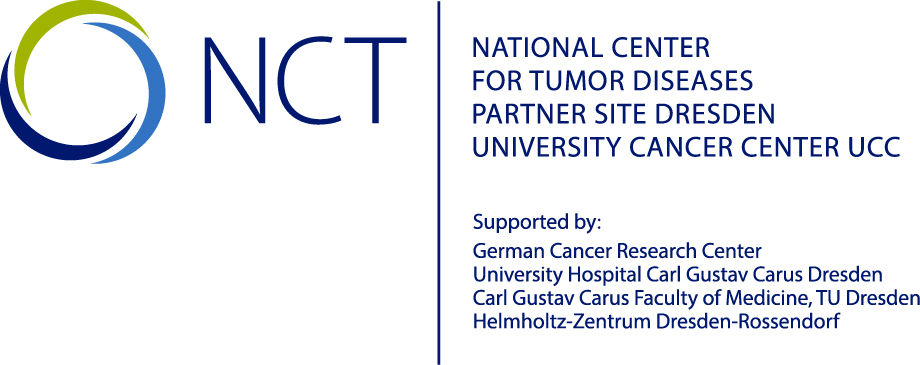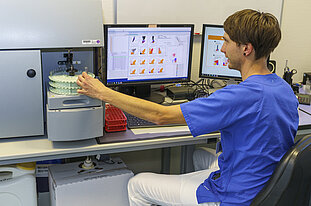Measurable residual disease (MRD) is a key factor in assessing therapy success in acute myeloid leukemia (AML) and adapting further treatment to the individual patient. MRD diagnostics is not yet available everywhere. An international research team led by scientists from University Hospital Carl Gustav Carus in Dresden and the National Center for Tumor Diseases Dresden (NCT/UCC) has now developed a fast, easy-to-implement method for MRD measurement based on flow cytometry, and has tested it on samples from 246 AML patients. The method could make MRD diagnostics available for many more patients in the future and improve cross-center comparability of measurement results.
The National Center for Tumor Diseases Dresden (NCT/UCC) is a joint institution of the German Cancer Research Center (DKFZ), University Hospital Carl Gustav Carus Dresden, the Faculty of Medicine Carl Gustav Carus of TU Dresden and the Helmholtz-Zentrum Dresden-Rossendorf (HZDR).
With around 4,100 new diagnoses in Germany each year, acute myeloid leukemia (AML) is a rare disease, but it is the most common form of acute leukemia in adults. After undergoing intensive induction chemotherapy, about 70% of patients achieve remission, with no leukemia cells visible under the microscope. However, without further treatment, 50% of these patients will suffer a relapse within six months. A key factor in estimating the individual risk of relapse and adapting further treatment accordingly is measurable residual disease (MRD). MRD is present if highly sensitive measurement methods, such as flow cytometry, can detect leukemia cells in the body even when the treatment has worked well and no leukemia cells can be detected using light microscope methods.
High-throughput flow cytometry can examine hundreds of thousands of cells for multiple cell surface characteristics simultaneously in a short space of time. Unlike other methods, flow cytometry can be used to measure MRD in nearly all AML patients. Until now, however, there was no rapid, standardized method to make widespread clinical application practicable and allow comparisons of measurement results between different centers. A team led by researchers in Dresden has now developed a method that can analyze and document 32 disease-relevant antigen combinations on cells in bone marrow samples in less than five minutes.
Dr. Malte von Bonin, co-leader of the study, who works at Medical Clinic I (MK I) at University Hospital Dresden, says: “The fast method makes MRD measurement using flow cytometry more efficient than previous approaches and increases laboratory capacity. It means that MRD diagnostics, which is currently performed at only a few major centers in Germany, could be established at other sites. At the same time, patients could be monitored more closely during the course of their treatment using MRD diagnostics.”
Dr. Uta Oelschlägel, co-leader of the study, who works at MK I at University Hospital Dresden, explains: “Since there is currently no standardized flow cytometry method for measuring MRD, study results in this area are not easily transferable to other centers. This situation could change in the future, thanks to the method we have developed, since it follows clearly defined rules and can be implemented in other centers.”
In flow cytometry, laser light is used to analyze cells (e.g. from blood or bone marrow) as they flow through the device in a fluid. Certain cell characteristics can be made visible by labeling them with fluorescent markers. The method developed in Dresden stains eight cell surface characteristics that are recommended by the European LeukemiaNet (ELN) as important MRD markers (CD34, CD13, CD7, CD33, CD56, CD117, HLA DR, CD45). A specially programmed database and analysis pipeline allows fast analysis and visualization of the 32 relevant antigen patterns. The analysis follows clearly defined, standardized steps. Flow cytometers that work with fluorescent dyes are available at university hospitals and in large diagnostics laboratories. Special expertise is needed when using flow cytometry for the diagnosis of acute myeloid and lymphatic leukemia.
The researchers tested the validity of the Dresden method on samples taken from 246 AML patients following induction chemotherapy and before any other treatment steps. Ninety healthy, leukemia-free bone marrow samples were used for reference. The patients in whom MRD was detected had a much shorter overall survival and a higher risk of relapse (2-year survival rate: 92% for MRD negative, 63% for MRD positive). “The prognostic value of our MRD diagnostic method for subsequent treatment was significant even when other important factors like age and leukemia genetic risk profile were included in the prognosis models,” says Dr. Maximilian Röhnert, the lead author of the paper, who works at MK I.
Prof. Martin Bornhäuser, a member of the managing directorate of NCT/UCC Dresden, explains: “If MRD is detected in a patient after the first one or two chemotherapy cycles, or does not disappear during the course of treatment, this can be a factor in recommending a stem cell transplant. Later in the treatment plan and even after the end of therapy, MRD diagnostics can provide valuable information when deciding whether to modify the treatment. In an ideal world, we would be able to measure MRD after every major treatment step and at regular intervals during follow-up care.” Prof. Michael Albrecht, Medical Director of University Hospital Dresden, adds: “Cancer is a very individual disease. Personalized oncology aims to tailor treatment as closely as possible to the individual biological characteristics of the disease. The advances in AML diagnostics are an important step on this journey.”
The new method is already being used in the laboratory of the Leukemia Study Alliance (Studienallianz Leukämie, SAL) at University Hospital Dresden, where around 2,000 samples from numerous German clinics are analyzed each year. In future, it could also be used at other centers with appropriate specialist laboratories.
Publication:
Röhnert, M.A., Kramer, M., Schadt, J. et al. Reproducible measurable residual disease detection by multiparametric flow cytometry in acute myeloid leukemia. Leukemia 36, 2208–2217 (2022). https://doi.org/10.1038/s41375-022-01647-5
A print-quality photo is available to accompany the press release:
https://www.nct-dresden.de/fileadmin/media/nct-dresden/das-nct/newsroom/pressemitteilungen/AML-Durchflusszytometer1.jpg
Caption:
Analysis of a bone marrow sample using the flow cytometer. © University Hospital Dresden/Marc Eisele
Notice of use for image material for press releases
Usage is free. The NCT/UCC Dresden permits one-time use in connection with reporting on the topic of the press release. Please enter the copyright © University Hospital Dresden/Marc Eisele. The image material may only be passed on to third parties after prior consultation with NCT/UCC Communications (phone: +49 351 458 5548, e-mail: anna.kraft@nct-dresden.de). Use for commercial purposes is prohibited.
Press contact:
Dr. Anna Kraft
National Center for Tumor Diseases Dresden (NCT/UCC)
Press and Public Relations
Tel: +49 (0)351 458-5548
E-mail: anna.kraft@nct-dresden.de
www.nct-dresden.de
Dr. Sibylle Kohlstädt
German Cancer Research Center (DKFZ)
Strategic Communications and Public Relations
Tel.: +49 (0)6221 42-2854
E-mail: s.kohlstaedt@dkfz.de
www.dkfz.de
Stephan Wiegand
Public Relations & Marketing Department
Carl Gustav Carus Medical Faculty of Dresden University of Technology
Tel.: +49 (0) 351 458-19389
E-mail: stephan.wiegand@tu-dresden.de
www.tu-dresden.de/med
Holger Ostermeyer
University Hospital Carl Gustav Carus Dresden
Press Office
Tel.: +49 (0)351 458 41 62
E-Mail: Pressestelle@uniklinikum-dresden.de
www.uniklinikum-dresden.de
Simon Schmitt
Communication and Media | Management and Press Spokesman
Helmholtz-Zentrum Dresden-Rossendorf
E-Mail: s.schmitt@hzdr.de
Tel.: +49 351 260-3400
www.hzdr.de
National Center for Tumor Diseases Dresden (NCT/UCC)
The National Center for Tumor Diseases Dresden (NCT/UCC) is a joint institution of the German Cancer Research Center, the Carl Gustav Carus Faculty of Medicine at TU Dresden, the Carl Gustav Carus University Hospital Dresden and the Helmholtz-Zentrum Dresden-Rossendorf (HZDR).
The NCT has made it its duty to closely link research and patient care wherever possible. That is why cancer patients at the NCT sites can be treated based on the latest research results. At the same time, the proximity of laboratory and clinic provides researchers with important impulses for their practice-oriented research. The NCT sites share the common goal of developing the NCT into a top international center for patient-oriented cancer research. The Dresden center draws on the structures of the University Cancer Center Dresden (UCC), which was founded in 2003 as one of the first Comprehensive Cancer Centers (CCC) in Germany. Since 2007, the UCC has been honored by the German Cancer Aid e.V. (DKH) as a "Top Oncological Center" on a continuous basis.
German Cancer Research Center (Deutsches Krebsforschungszentrum, DKFZ)
The German Cancer Research Center (Deutsches Krebsforschungszentrum, DKFZ) with its more than 3,000 employees is the largest biomedical research institution in Germany. More than 1,300 scientists at the DKFZ investigate how cancer develops, identify cancer risk factors and search for new strategies to prevent people from developing cancer. They are developing new methods to diagnose tumors more precisely and treat cancer patients more successfully. The DKFZ's Cancer Information Service (KID) provides patients, interested citizens and experts with individual answers to all questions on cancer.
Jointly with partners from the university hospitals, the DKFZ operates the National Center for Tumor Diseases (NCT) in Heidelberg and Dresden, and the Hopp Children's Cancer Center KiTZ in Heidelberg. In the German Consortium for Translational Cancer Research (DKTK), one of the six German Centers for Health Research, the DKFZ maintains translational centers at seven university partner locations. NCT and DKTK sites combine excellent university medicine with the high-profile research of the DKFZ. They contribute to the endeavor of transferring promising approaches from cancer research to the clinic and thus improving the chances of cancer patients.
The DKFZ is 90 percent financed by the Federal Ministry of Education and Research and 10 percent by the state of Baden-Württemberg. The DKFZ is a member of the Helmholtz Association of German Research Centers.
University Hospital Carl Gustav Carus Dresden
The University Hospital Carl Gustav Carus Dresden offers medical care at the highest level of care. As a full-service hospital, it covers the entire spectrum of modern medicine. The University Hospital combines 20 clinics and outpatient departments, four institutes and ten interdisciplinary centers that collaborate closely with the clinical and theoretical institutes of the Faculty of Medicine.
With 1,295 beds and 160 places for day-care treatment, the Dresden University Hospital is the largest hospital in the city and also the only full-service hospital in eastern Saxony. Around 860 doctors cover the entire spectrum of modern medicine. 1,860 nurses and caregivers ensure the patients' well-being. The medical care of patients suffering from cancer, metabolic and neurodegenerative diseases is an important focus of treatment at the University Hospital.
Germany's largest hospital comparison by the news magazine "Focus" confirms that the University Hospital Carl Gustav Carus Dresden provides an excellent quality of treatment. That is why Dresden's university medicine comes second in the Germany-wide ranking.
Carl Gustav Carus Faculty of Medicine at Technische Universität Dresden
The Dresden University Medicine, consisting of the Carl Gustav Carus Faculty of Medicine and the university hospital of the same name, has specialized in research in the fields of oncology, metabolic as well as neurological and psychiatric diseases. Within these focal areas, the topics of degeneration and regeneration, imaging and technology development, immunology and inflammation, as well as prevention and health care research are of particular interest. International exchange is a prerequisite for top-level research - the Dresden University Medical Center embraces this concept with employees from 73 nations and numerous collaborations with researchers and teams from all over the world.
Helmholtz-Zentrum Dresden-Rossendorf (HZDR)
The Helmholtz-Zentrum Dresden-Rossendorf (HZDR) conducts research in the fields of energy, health and matter. It focuses on the following questions:
• How can energy and resources be used in an efficient, safe and sustainable way?
• How can cancer be better visualized, characterized and effectively treated?
• How do matter and materials react under the influence of strong fields and in smallest dimensions?
To answer these scientific questions, the HZDR operates large infrastructures that are also used by external measurement guests: Ion Beam Center, High Field Magnetic Laboratory Dresden and ELBE Center for High Power Radiation Sources.
The HZDR is a member of the Helmholtz Association, has five sites (Dresden, Freiberg, Grenoble, Leipzig, Schenefeld near Hamburg) and employs almost 1,200 people - about 500 of whom are researchers including 170 PhD students.







